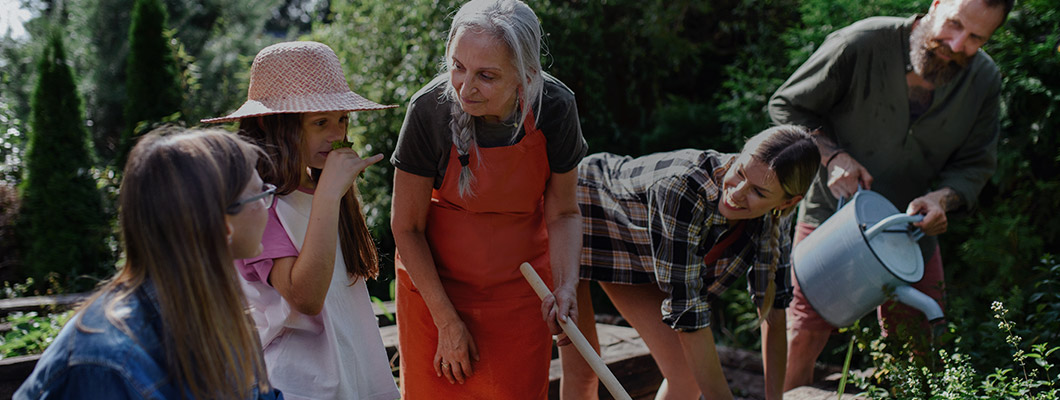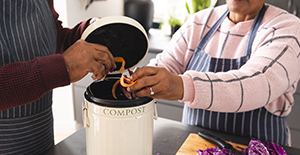Recycling our plastic, glass, and metal is second nature for many of us. It’s easy to understand why we should be keeping these materials out of landfills. But did you know you can recycle more than that?
We can use nature’s recycling system to turn our food scraps, paper trash, and yard trimmings into compost. It’s so simple; anyone can do it. But why is it important?
The power of composting
Composting is a way to keep harmful greenhouse gases from being emitted into the atmosphere. According the US Environmental Protection Agency, food is the largest category of material buried in US municipal landfills. As it rots, it emits methane — a powerful greenhouse gas that’s responsible for 30% of the rise in global temperatures since the Industrial Revolution. And municipal solid waste landfills are the third-largest source of human-related methane emissions in the US.
But, there’s an easy, low-maintenance solution to this stinky problem: composting.
Composting 101
Composting requires the right balance of four elements: “greens,” “browns,” air, and water.
- Greens are things like banana peels, onion skins, carrot tops, and other fruit and vegetable scraps.
- Browns are things that come from trees like leaves, twigs, cardboard, and paper grocery sacks.
- Air and water feed the microorganisms that break down the green and brown items into compost.
Get started
- Decide how you will collect and store your browns and greens.
- For greens, keep your food waste in a closed container in your fridge or freezer until you’re ready to add it to the pile.
- For browns, set aside an area outside to store your leaves, twigs, paper, cardboard boxes, and other carbon-rich material.
- Choose a composting spot and consider your bin options.
- Outside: If you have enough space, your backyard can host your compost pile or bin. Put it somewhere that is easily accessible year-round and has good drainage. Avoid placing it right up against a fence. It’s best to have a water source nearby.
- Inside: There are countertop composting machines on the market that make quick work of converting your scraps into soil. There’s also vermicomposting to consider.
- Prepare your ingredients. Before adding your browns and greens to the pile, try to chop and break them up into smaller pieces to help them break down faster.
- Start your compost. Start with a four- to six-inch layer of bulky browns such as twigs, dry leaves or cardboard chunks. This layer will absorb extra liquids and allow air to circulate at the base of the pile or bin. Then layer your greens and browns like a lasagna. If needed, add a little water to dampen the pile.
Maintaining and sustaining your compost
Add at least two to three times the volume of browns (such as dry leaves and cardboard) to the volume of greens (such as food scraps). Always ensure your food scraps are covered by four to eight inches of dry leaves or other browns. Turning and mixing your pile from time to time will help speed up the decomposition process and aerate the pile. Use a garden fork to turn the outside of the pile inward.
It could get hot
As the materials in your compost pile begin to decompose, the temperature of the pile will initially begin to rise, especially in the center. A backyard pile, if well maintained, can reach temperatures of 130° to 160° F. These high temperatures will kill germs and weed seeds.
How to know it’s done
When your compost pile is no longer heating up after mixing, and when there are no visible food scraps, it’s almost ready. Leave your pile to cure for at least four weeks. Do that by moving the oldest compost (at the bottom of the pile) to a separate area or simply stop adding materials to your pile or bin.
Compost in a well-maintained pile will be finished and ready for use in about three to five months. The compost will look dark, loose, and crumbly and smell like fresh soil. Most, if not all, of what went into the compost pile should be decomposed.
Composting is easy recycling anyone can do almost anywhere. It can make a big difference to our environment and give you nutritious soil to feed your houseplants, lawn and garden. Give it a try and see how easy it can be.
Sources:
“Composting At Home,” United States Environmental Protection Agency (epa.gov)
“Why Should We Care About Food Waste?” United States Department of Agriculture (usda.gov)
“Digging in the Dirt: 4 Home Composters Reviewed and Rated,” Wired (wired.com), March 31, 2022
“Vermicomposting for Households,” NC State Extension (composting.ces.ncsu.edu)
“Methane emissions remained stubbornly high in 2022 even as soaring energy prices made actions to reduce them cheaper than ever,” International Energy Agency (iea.org), February 21, 2023


